
Detailed drawing by Matt Strieby (2018.04).
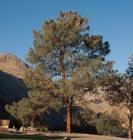
A typical mature tree in the Kern River gorge, California [C.J. Earle, 2014.01.17].
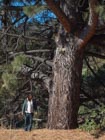
Trunk and bark of a large Pinus coulteri at Palomar Mtn., CA [C.J. Earle, 2012.12.20].
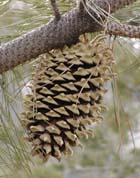
Cone (Mt. San Jacinto, California) [C.J. Earle, 2002.03.06].
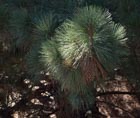
Pinus coulteri foliar units and mature cone; Palomar Mtn., CA [C.J. Earle, 2012.12.20].
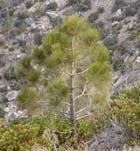
Sapling (Mt. San Jacinto, California) [C.J. Earle, 2002.03.06].
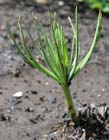
Coulter pine seedling about 4 cm tall in King Creek RNA, CA [C.J. Earle, 2004.04.09].
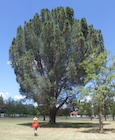
A fine open-grown ornamental at Fort Bayard, NM [Richard Felger, 2018.08.19]. Dr. Felger reports the species is naturalizing in the vicinity of the Fort.

Pinus coulteri buds and foliage at Palomar Mtn., CA [C.J. Earle, 2012.12.20].

Conservation Status

Pinus coulteri
D. Don 1836
Common names
Coulter, bigcone, nut or pitch pine (Peattie 1950).
Taxonomic notes
No synonyms. For the type locality, we have: "Discovered by Dr. Coulter on the mountains of Santa Lucia, near the Mission of San Antonio, in latitude 36°, within sight of the sea and at an elevation of from 3000 to 4000 feet above its level. It was growing intermingled with Pinus Lambertiana" (Don 1836).
This is a member of subsection Ponderosae, and is generally recognized as closely related (morphologically, geographically, and genetically) to Pinus sabiniana, P. torreyana, and P. jeffreyi; the three taxa form group Sabinianae Loudon 1838 (Pinus jeffreyi, though morphologically a bit different, is known to hybridize with P. coulteri, and molecular analysis clearly places it in the Sabinianae [Willyard et al. 2009]). P. coulteri, alone in the Sabinianae, also shares a chlorplast haplotype with P. arizonica of the northern Sierra Madre. It seems likely that the species arose through a hybridization event involving two members of subsection Ponderosae (Willyard et al. 2009).
Description
"Trees to 24 m; trunk to 1 m diam., straight to contorted; crown broad, thin, irregular. Bark dark gray-brown to near black, deeply furrowed, with long, scaly, irregularly anastomosing, rounded ridges. Branches often ascending; twigs stout to moderately slender, violet-brown, often glaucous, aging gray-brown, rough. Buds ovoid, deep red-brown, 1.5(-3) cm, resinous; scale margins white-fringed, apex cuspidate. Leaves 3 per fascicle, slightly spreading, not drooping, mostly ascending in a brush, persisting 3-4 years, 15-30 cm x ca. 2 mm, slightly curved or straight, twisted, dusty gray-green, all surfaces with pale, fine stomatal lines, margins serrulate, apex abruptly subulate; sheath 2-4 cm, base persistent. Pollen cones ovoid to cylindric, to 25 mm, light purple-brown, aging orange-brown. Seed cones maturing in 2 years, gradually shedding seeds thereafter and moderately persistent, massive, heavy, drooping, asymmetric at base, narrowly ovoid before opening, ovoid-cylindric when open, 20-35 cm, pale yellow-brown, resinous, stalks to 3cm; apophyses transverse-rhombic, strongly and sharply cross-keeled, elongate, curved, continuous with umbos to form long, upcurved claws 2.5-3 cm. Seeds obovoid; body 15-22 mm, dark brown; wing to 25 mm. 2n=24" (Kral 1993). See García Esteban et al. (2004) for a detailed characterization of the wood anatomy.
Distribution and Ecology
USA: California and Mexico: Baja California Norte, at 300-2100 m. Pinus coulteri is usually found on " dry rocky slopes, flats, ridges, and chaparral, transitional to oak-pine woodland" (Kral 1993).
Distribution data from USGS (1999).
In Alta California, it occurs from Mount Diablo (E of San Francisco) S in scattered groves through the Santa Lucia, San Bernardino and San Jacinto Mountains to the Cuyamaca Mountains of San Diego County (Peattie 1950). In Baja California, it is found in isolated occurrences in the Sierra Juárez (e.g., one stand at 1250 m on Sierra Blanca, isolated colonies at 1500 m SW of Rancho San Faustino, and at 1800 m on hillsides immediately W and NW of Laguna Juárez) and in small stands on the Sierra San Pedro Mártir, where it is found on northern exposures at 1900-2150 m (Minnich 1987).
Hardy to Zone 8 (cold hardiness limit between -12.1°C and -6.7°C) (Bannister and Neuner 2001). See also Thompson et al. (1999).
Remarkable Specimens
The largest known specimen is a tree planted at Otekaieke, North Otago, New Zealand. First measured in 1984 at 169 cm dbh and 35.4 m tall (Cadwallader 2010), the remeasurement at the end of 2015 found it to be 179 cm dbh and 36.6 m tall (New Zealand Notable Trees Register, accessed 2024.08.12). In 2024 it remains very healthy. The U.S. national champion in 2010 was considerably smaller at 123 cm dbh, height 43.0 m, growing near Julian, California (American Forests 2010); as of 2024 there is no stated champion, and due to the severe droughts and fires that have afflicted this species within habitat during the 21st century, it seems likely that the largest specimens will be cultivated trees for some time yet.
Ethnobotany
Observations
Vladimir Dinets (e-mail 2003.10.18) reports that "An impressive stand of very large Pinus coulteri, Abies bracteata, and (surprise!) Pinus lambertiana can be seen by driving to the end of Cone Peak Rd. (about a mile past Summit trailhead), and walking the only trail there for less than 5 min. knobcone and ponderosa pines are also present there." For additional guidance: this stand is in the Santa Lucia Mountains (which also harbor the southernmost wild specimens of Sequoia sempervirens). Information on the Cone Peak Road and Summit Trail is available from Los Padres National Forest.
Also seen on Mt. San Jacinto (east of Los Angeles) and in the Sierra San Pedro Martír of northern Baja, both times old growth forest in mixed conifer associations with Abies concolor and Calocedrus decurrens. In the southern Laguna Mountains (east of San Diego), it forms pure stands or stands with P. jeffreyi and, as a consequence of fires, the stands vary widely in age from recent burns to large, mature trees. Also in the Laguna Mountains, it often grows in association with oaks, and the acorn woodpeckers store vast quantities of acorns in holes pecked out in Coulter and Jeffrey pine bark. My notes from that trip (spring 2001) record:
"We collect Coulter pine cones in the Laguna Mountains (32° 50.189' N, 116° 27.047' W ). They come from a young stand that recently carried a ground fire. Trees are fairly dense, may have been planted. Most are 15-35 cm dbh, 10-13 m tall. These cones are borne either sessile or stalked, and they tend to be borne sessile near the trunk or stalked near the outer branch ends (halfway out to 90% of the way out), though they are never borne right at the branch tips - I expect their weight would break off a young branch."
Remarks
Has the heaviest cone of any pine (Kral 1993).
Citations
American Forests 2010. The National Register of Big Trees 2010. Washington, DC: American Forests.
Cadwallader, Brad. 2010.11.28 email. New Zealand Notable Trees Trust, http://www.notabletrees.org.nz/.
Don, D. 1836. Descriptions of five new species of the genus Pinus discovered by Dr. Coulter in California. Trans. Linn. Soc. London 17:439-444 (p. 440).
Willard, A., R. Cronn, and A. Liston. 2009. Reticulate evolution and incomplete lineage sorting among the ponderosa pines. Molecular Phylogenetics and Evolution 52:498-511.
See also
Elwes and Henry 1906-1913 at the Biodiversity Heritage Library (as P. excelsa). This series of volumes, privately printed, provides some of the most engaging descriptions of conifers ever published. Although they only treat species cultivated in the U.K. and Ireland, and the taxonomy is a bit dated, still these accounts are thorough, treating such topics as species description, range, varieties, exceptionally old or tall specimens, remarkable trees, and cultivation. Despite being over a century old, they are generally accurate, and are illustrated with some remarkable photographs and lithographs.
Farjon & Styles (1997).
Perry (1991).
Little (1980).
FEIS database.









